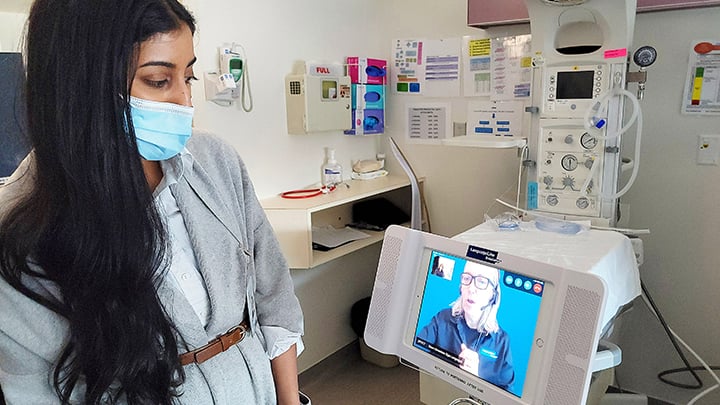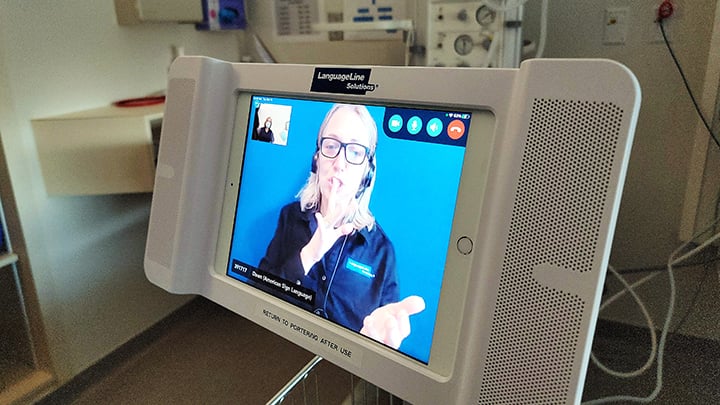
The healthcare system can seem complex and confusing, especially during an emergency when emotions and nerves run high. For patients and families who don’t speak English, at times it can be overwhelming.
This is the reality for thousands of people across North America in Emergency Departments, delivery suites, operating rooms and inpatient units. Fortunately, LanguageLine Rolling Carts (sometimes affectionately called “Interpreters on Wheels”) have been rolling out in hospitals like Canada’s Red Deer Regional Hospital Centre (RDRHC) to break down language barriers.
“Using the (LanguageLine Rolling Cart) has really simplified and streamlined our ability to bring in translation services to support our patients,” says Michelle McCutcheon, Patient Care Manager for Women’s and Children's Health Services at RDRHC.
The hospital currently has three rolling cards, including one in its emergency department.
“With the video capabilities and the portability of these units, we’re able to bring an interpreter right to the patient’s side,” McCutcheon said. “They and our staff can see and interact with them in a way that is patient-centered.”

Looking much like a vitals machine that measures blood pressure and oxygenation, the IOWs offer a sleek design and portability that allows them to be wheeled to a patient’s bedside, into an operating room, or brought to a family care conference.
More impressive, however, are the breadth of language services they offer — and just how much their use has risen across Alberta Health Services (AHS).
More Than Two Million Minutes of Interpretation
“Last year 2.3 million minutes of interpretation services were provided in more than 157 languages, including American Sign Language, to support patients and staff alike,” says Kayathiri Ganeshamoorthy, Provincial Program Lead with AHS’ Interpretation and Translation Services team.
“There are now more than 120 of these units across the province.” said Ganeshamoorthy, who speaks Tamil, French and English fluently. She says she has experienced firsthand the difficulties and confusion that can arise for patients and their families when there are language barriers. At a young age, she found herself in the role of interpreter for her parents, first in France and later in Canada.
“When people are in pain or crisis, they often revert to their native tongue or their first language,” says Ganeshamoorthy. “With the rolling carts, healthcare providers can connect on-screen in under a minute with a professional medical interpreter to aid communication with patients, allowing family members to just be family members.
“Being able to access a translator who speaks their first language helps make patients feel more comfortable sharing information and empowers them to make choices for themselves. And it means family members aren’t in a position of having to convey medical information. They can just be there, supporting their loved one.”
In addition to helping staff and patients communicate in a crisis, the IOWs have also played an important role in patient education, being used by McCutcheon’s teams to help impart breastfeeding and other post-natal information. The interpreters have also taught staff an important thing or two.
“We’ve learned to say ‘push’ in a lot of languages,” says Patti Plosz, Assistant Head Nurse on the labor and delivery unit at RDRHC. “In all seriousness, the (LanguageLine Rolling Cart) is very helpful in being able to learn about our patients. We’re able to help make them feel more at ease and can build a connection with them through the interpreter’s help.”
In 2022, the carts supported interpretation in 46 different languages for patients at RDRHC, with the five most requested being Arabic, Amharic, Spanish, Tagalog and Mandarin.
With as much as 20 percent of the Canadian population not speaking English as a first language, both McCutcheon and Ganeshamoorthy predict the need for translation and interpretation will only grow.
“I would love to see a (rolling cart) in every unit in the future,” says McCutcheon. “They’re such an incredible tool for supporting our patients, and they really do make a difference.”

